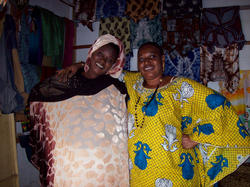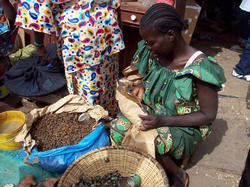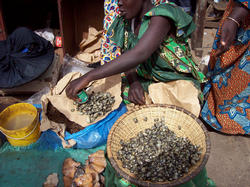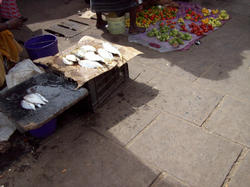The Markets
Shopper's Delight - The Marketplaces
One true consistency throughout both The Gambia and Senegal are their markets. The marketplaces seemed to be the life's blood of the communities in these countries, and it is probably this way throughout Africa. Life generally centers around the marketplaces, whether they are selling crafts and jewelry, food, household supplies, furniture, auto parts, clothing, audio and video parts, or anything else from A to Z. What surprised me most, and maybe this was just because I was there in December and January (the supposed off-season for tourists), was that the markets were crowded with the local people--they were selling mostly to each other.
There are small huts of market areas along many of the roadsides; huge, massive, mega-block size markets, single vendors on the streets with hand-driven and animal-driven carts, or a solitary man, woman or child sitting on a mat selling fruit or peanuts. In high traffic areas there were always women and young girls with large trays on their heads selling fruit, peanuts and water. Here are just a few pictures to give you an idea. Hopefully, I'll be able to upload one of my videos to the website, and you can follow along as we walked through the market in Banjul. Check back later for that addition.
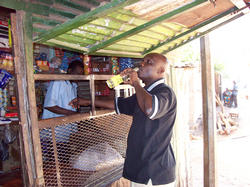
That's Pierre in front of one of the small neighborhood stores. There was at least one on every block, sometimes more. We drank a lot of tonic water because the Quinine helps ward off Malaria.
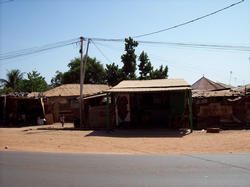
This may give you an idea of how a small street-stall market may look, with the stalls stretched out along the roadside.
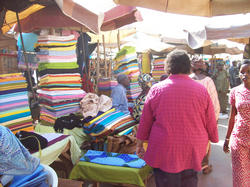
Another part of the huge market in Dakar. There were what seemed like miles and miles of booths like this these. We were there to look at fabrics but there were just too many to choose from.
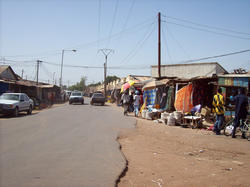
This is just a small section of the large marketplace in Brikana, about 10 miles from Banjul.
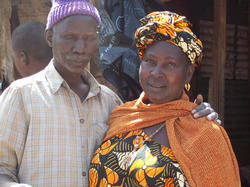
This nice man sold us the Baobab fruit in the last photo, and he and this lady got such a kick out of my reaction when I was tasting the white seeds. Since they were laughing at the strange American lady, I asked to take their picture and they were delighted.
The wonderful lady on the left tried so hard to sell me everything she had. Then she brought us to meet her sister and together they still couldn't sell us. They had some beautiful fabrics (too expensive for our budget) and we had the most fun with them. They were thrilled to pose for us.
More oysters. There's a stretch of road between Banjul and Bakau along The Gambia River that is filled with millions of oyster shells.
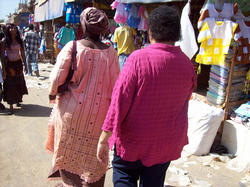
My sister-in-law, Cathy, took us on a dizzying journey through a huge marketplace in Dakar.
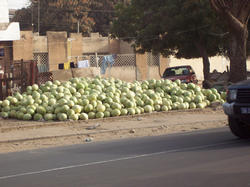
Whatever someone may have to sell -- they can just set it up on any street. Here, tons of watermelons!
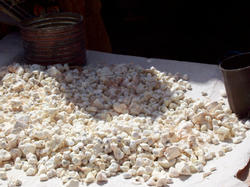
This is the fruit of the Baobab tree. The white "pulp" covers the seeds. Historically, the Baobab tree has many uses, including many medicines. Pierre's Aunt spent all day mixing it with rice and pounding it into a fine powder, which when mixed with water, flavoring and fruit, made a delicious yogurt-type dessert (but it was not as thick as yogurt). It's usually made for holidays, especially Easter. It was really good!
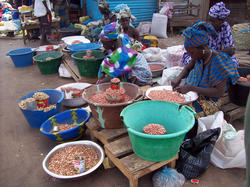
In Africa, these are called "ground nuts", but they're peanuts to you and me. The Groundnut is The Gambia's largest export. Along with cashews, which grow on trees all over the place, they are sold absolutely everywhere!
You have to look closely to see these are oysters. They are extremely popular in The Gambia. They were much different than what I'm used to seeing here (and always refused to eat), but I ate these in a delicious stew.
Here you can see the fish displayed for sale, and next to them, all different types of tomatoes.
And these are coconuts. This man was selling them on the street in Dakar. They don't look like the coconuts I had seen before, which are usually brown with what I always called "hair" all over them. These looked like rocks or something, but these are unripened coconuts. First they are cut at the top so you can drink the coconut milk (which was like water to me--a clear, almost sweet but more bland liquid). When you're done with that, he takes the nut and goes through a process of splitting and cutting so you can eat the inside. Ours was more ripe than usual, so I didn't get the full effect of what is usually an even softer inside white part he calls the jelly. Eaten like this, it was really good. Here in the States, I don't like coconut and won't even touch a Mounds candy bar! New sights, new sounds, and definitely new tastes. I loved everything. Even the Okra Stew.
